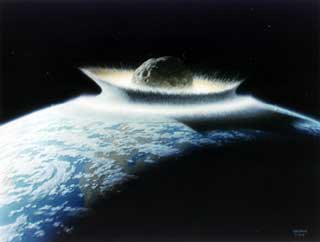
THE WASHINGTON POST
10-28-05
EASTVILLE, Va.10-28-05
A fireball two miles across and traveling at 30,000 mph crashes into the ocean off the Virginia coast. The impact vaporizes billions of tons of water, rips a hole in the sea floor six miles deep and fractures the bedrock far into the Earth.
The splash is 30 miles high. Debris is lofted over the horizon and rains down on an area of 3 million square miles, as distant as the Antarctic. Towering tsunamis surge toward the Blue Ridge Mountains. A calamity of unimaginable scale, it is probably the most stupendous geological occurrence on the East Coast.
For more than 10 years, geologists have believed that an asteroid or a comet struck the Earth north of Norfolk about 35 million years ago, leaving behind behind a 53-mile-wide, long-buried crater.
An international team of scientists, looking for clues into the origins of the planets, has assembled in a windblown bean field near the crater's center to try to determine, among other things, what happened when the object struck.
Since early last month, the team has been working with a large drilling rig to bore through eons of sediment toward the floor of the crater, perhaps 7,000 feet below the surface.
"This is so big that we can't really picture it," said David Powars, a geologist with the U.S. Geological Survey, who said he first suspected the presence of an impact crater in the 1980s. "You could take the whole nuclear arsenal in its heyday: Russia, China, U.S.... That's a firecracker compared to what this explosion would be."
Their work is the culmination of a five-year project in which the USGS has drilled six holes to examine the crater's shape. This hole will be the program's deepest, and the last, officials say.
Since the formal announcement in 1995 of what is now called the Chesapeake Bay Impact Crater, studies have detailed its dimensions and outline, experts say. Last year scientists for the first time found rock that had been melted by the impact and fossils of microorganisms that were smashed in the collision.
There are many known impact sites around the world and millions more on planets and moons across the solar system. The one near Norfolk is Earth's seventh-largest and the biggest in the United States.
The Earth's biggest, 186 miles across, is at Vredefort, South Africa.
The third-largest, the 100-mile-wide Chicxulub crater on Mexico's Yucatan Peninsula, is believed to be the result of an impact 65 million years ago that blew so much debris into the atmosphere that it darkened the Earth for months and led to the extinction of the dinosaurs.
Geologists say they do not believe that kind of thing happened after the Chesapeake impact. It "would have killed off the local population" for hundreds of miles up and down the coast, said Jean Self-Trail, a Geological Survey micropaleontologist. "But we don't really have any evidence that there was a massive die-off."
More . . .
Home
No comments :
Post a Comment
Dear Reader/Contributor,
Your input is greatly appreciated, and coveted; however, blatant mis-use of this site's bandwidth will not be tolerated (e.g., SPAM, non-related links, etc).
Additionally, healthy debate is invited; however, ad hominem and or vitriolic attacks will not be published, nor will "anonymous" criticisms. Please keep your arguments/comments to the issues and subject matter of this article and present them with civility and proper decorum. -FW